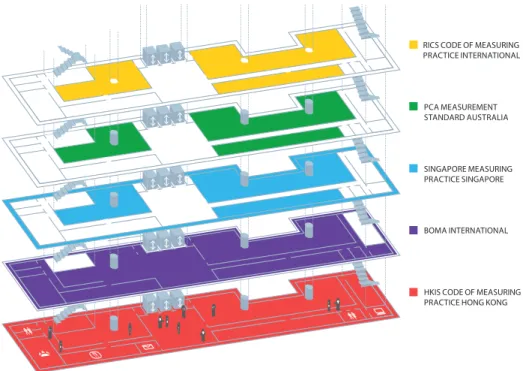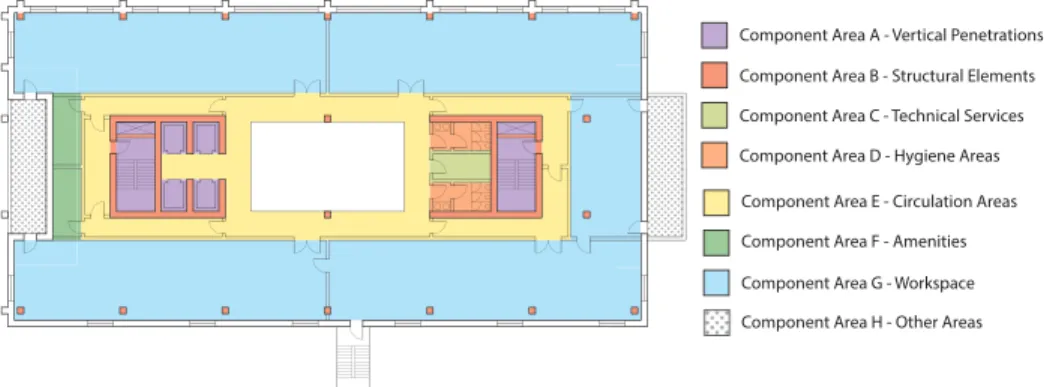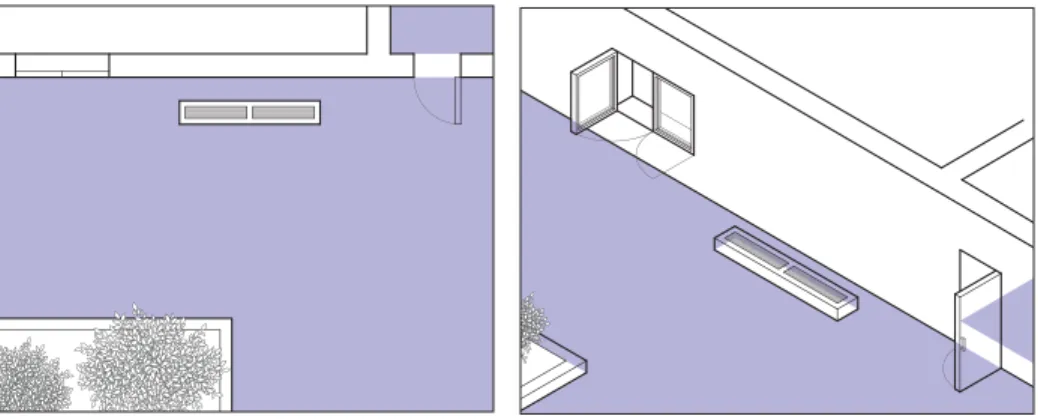Creating Industry-Accepted Criteria for
Measuring Tall Building Floor Area
Height, Data & Criteria
William Miranda Dario Trabucco
Authors
William Miranda, Research Assistant Dario Trabucco, Research Manager
CTBUH Research Office Iuav University of Venice Dorsoduro 2006 30123 Venice Italy t: +39 041 257 1276 e: [email protected] www.ctbuh.org
William Miranda has been involved with a number
of CTBUH research activities. He joined CTBUH, primarily to develop the CTBUH website and database. In 2016, Miranda moved to Italy to provide editorial services and research assistance for the CTBUH Research Office in Venice. In addition to his research work, he also coordinates and manages videos and building drawings produced for the Council. He received his Bachelor’s in Architecture from the Illinois Institute of Technology.
Dario Trabucco is CTBUH Research Manager and a
researcher at the IUAV University of Venice, Italy. He is involved in teaching and research activities related to tall buildings, including the life cycle analysis of tall buildings, service core design and issues pertaining the renovation and of tall buildings. In 2009, he obtained a PhD in building technology. This research examines the implications of alternative service core placement in relation to the embodied energy and the energy consumption of a tall building. He has managed the activities of the Research Division and CTBUH operations in Europe since 2014.
Introduction
If the ultimate objective of a building is to host, within its enclosure, a human activity, then the measurement of its internal floor area should reflect that objective. As the arbiter of height criteria and standards of measurement for tall buildings, the Council on Tall Buildings and Urban Habitat (CTBUH) is in a key position to assist the industry in coming to a consensus on how floor area is measured. In recognition of this, CTBUH received funding from ArcelorMittal to begin examining the existing strategies and complications around floor-area Abstract
The entire tall building industry relies on floor-area
measurements to serve as a precise, unambiguous
calculation to guide decisions. This can range from
architects using the measurement to influence
design interventions and engineers formulating the
loads on their systems, to developers determining
the value of their assets and property managers
analyzing the efficiency of building components.
Unfortunately, the measurement systems for determining
this floor area are not consistent across all markets, which creates a massive gap in
the ability to compare projects across time and location, preventing evaluation of
the success of one project against another, and making it difficult to build upon
industry decisions made in the past. Work to create floor-area measurement
standards that are accepted internationally is underway, but there is hesitancy from
investors, governing bodies, and professionals that have used different methods for
many years. This paper, one of the outputs of a one-year research project funded by
ArcelorMittal, examines some of the problems with existing, local regulations, and
presents the progress that has been made towards a globally-accepted standard.
Keywords: Floor Area, Real Estate Valuation, Standards, Materials
“
Due to inconsistencies and variations in
measuring standards between different
markets, declared areas of the same building
can deviate up to 24%.
”
measurement. Measuring a building is a deceptively straightforward task, but
exploration of the methods produces a wealth of discrepancies and unfamiliar acronyms. Precise floor measurements are crucial for all disciplines within the tall building industry and serve as a valuable tool when conducting cost surveying/comparison analysis, or when determining planning permissions, maximum allowable floor occupancies, energy
consumption, elevator capacity, etc. In all of these crucial activities, an accurate floor measurement is needed to serve as a basis of comparison to determine a building or space’s “per-square-meter” efficiency and value – figures expressed in dollars per square meter, energy usage per square meter, occupancy per square meter, construction speed at number of square meters per day, etc. With an accurate measurement, it is possible to compare buildings across markets and across time, but the cardinal stipulation is that the measurement system must be consistent, clear, and internationally accepted.
“Creating Industry-Accepted Criteria for Measuring Tall
Building Floor Area”
– A CTBUH Research Project, kindly sponsored by:
Figure 1. Differing measurement strategies, applied to identical buildings, can produce up to a 24% deviation in declared floor area. © IPMSC
RICS CODE OF MEASURING PRACTICE INTERNATIONAL PCA MEASUREMENT STANDARD AUSTRALIA SINGAPORE MEASURING PRACTICE SINGAPORE BOMA INTERNATIONAL
HKIS CODE OF MEASURING PRACTICE HONG KONG
In a study by global property firm JLL, it was found that, due to inconsistencies and variations in measuring standards between different markets, declared areas of the same building can deviate up to 24% (Hall 2016). This can have huge implications. For example, in an office building, it may be determined that each employee needs at least a total of 10 square meters to work comfortably. By dividing the total floor area by 10, this can determine the amount of employees that can work in a specific area (i.e., the population of the space). With measurement deviations of 24%, a potential office tenant may be looking for space for 100 employees, but the leased or purchased space may only be suitable for 76 members of staff. This global variation in standards has been an impediment to international investment, particularly for office buildings (see Figure 1).
Acknowledging the need for a consistent method across international markets, and to promote international investments, the International Property Measurement Standards Coalition (IPMSC) was established in 2013 by the World Bank, with the sole mission of developing and implementing international standards for measuring the floor area of property. CTBUH joined this group of more than 80 professional and not-for-profit organizations from around the world, to contribute considerations on the unique aspects of tall buildings and their impact on the development of an internationally-accepted standard.
Existing Standards
In every major tall building market, there is an accepted method for measuring floor area, but often the organization or standard that is referenced and relied upon differs. The Royal Institute of Chartered Surveyors (RICS) is a global professional body dedicated to promoting and enforcing standards in land, real estate, construction, and infrastructure. While the standards and regulations that they have produced on how to measure property are primarily used in the United Kingdom, they also have an impact on the
standards being implemented in other countries. Like RICS, the Building Owners and Managers Association (BOMA) is
internationally known for setting the standard for measuring buildings, beginning with the publication of the Standard Method
of Floor Measurement for Office Buildings in
1915. The BOMA standards are the approved methodology for measuring floor area by the American National Standards Institute (ANSI), making it the most widely-used standard for measurement in the United States. While jurisdictions outside of the UK and US utilize the standards created by RICS and BOMA, they also generally employ the specific standards produced by their respective governments. For example, in Hong Kong, the Building (Planning) Regulations produced by the Hong Kong Buildings Department are used; in Australia, the Property Council of Australia (PCA) Methods of Measurement is used; and in Singapore, the Handbook on Gross Floor Area produced by the Urban Redevelopment Authority (URA) is used.
Within these standards, a building’s floor area is commonly defined by Gross Floor Area (GFA) or Gross External Area (GEA); however, there are countless other terms used,
including the Gross Internal Area (GIA), Net Internal Area (NIA), Gross Leasable Area (GLA), Net Rentable Area (NRA), and Carpet Area, among others. All of these methods for measurement differ in the specific building elements that they include or exclude. Also, the same definition may vary from standard to standard, so the NRA may not be the same from one market to the next. When a potential tenant is looking at a new building unit, the total cost is often dictated by a monetary value per square meter, multiplied by the total area. Without a single,
internationally-accepted practice for measuring the area, the total value of that area is not uniquely identifiable.
Existing measurement practices
Generally, GFA and GEA are considered to be the total floor area contained within a building’s envelope, measured to the external face of the external walls. This is the “all-inclusive” measurement, and generally the biggest number used when defining a building’s floor area. Along with being the most common method for measuring building floor areas, it is also considered the simplest and least-controversial method. Using GFA and GEA measurements is the typical method used for city planning
Figure 2. In order to maximize the internal, usable space, developers in Hong Kong could be motivated to simply “extrude” the floor plan, as protruding building features, such as balconies, can count against the total allowable floor area for a building site. © WiNG (cc by-sa)
applications and approvals, as well as calculating building costs for residential insurance purposes (Cartlidge 2017). In many buildings, measuring to the external face is a straightforward process, without triggering a need to consult standards and criteria. With that said, construction projects – particularly on tall buildings – are starting to incorporate new building elements and technologies that require further specificity in the existing standards. This can lead to discrepancies in the basic floor area measurement in properties, which may be architecturally identical, but are located in different countries. For example, in the RICS
Code of Measuring Practice (6th Edition),
when measuring for GEA, all external open-side balconies and canopies are excluded from the measurement, as well as all parking areas and greenhouses (RICS 2015). Conversely, in the Building (Planning) Regulations, which is the equivalent measuring practice for Hong Kong, the GFA is the area contained within the external walls of the building, together with the area of each balcony in the building, including the thickness of the external walls and sides of the balconies (Hong Kong BD 2018). As GFA and GEA are generally used to help determine the cost of property and are figures reported to potential tenants, the decision to include or exclude balconies in a design could be solely dictated by whether the building is located in Hong Kong or London. The desire for developers and property managers to maximize the value of their properties could outweigh the architectural and occupant benefit of including a specific building element (see Figure 2).
Building innovation and the impact on standards
To further complicate the aspiration for global consistency, governing bodies will regularly make adjustments to existing standards, usually with the goal of influencing the quality of space or advancement in the building industry.
For example, due to the fact that balconies are included in the measurement strategies found in the Building (Planning) Regulations of Hong Kong, there was a motivation to not include balconies in building design, in order to maximize the internal, usable space in a building – to the exclusion of potentially valuable and beneficial access to outdoor recreational space. As a result, the Building Department, Lands Department, and Planning Department issued Joint Practice Notes No. 1 and No. 2 to promote green and innovative buildings. These indicated that, upon application and review, certain green features in buildings could be excluded from the total GFA calculations. Not only could certain balconies, podiums, and skygardens with green features be excluded, but also common corridors and lift lobbies that incorporated sustainable elements (Hong Kong BD 2011a & 2011b) (see Figure 3). While these new rules in Hong Kong were largely seen as a beneficial move for the environment and advancement of the building industry, the decision to measure balconies, lift lobbies, and even basic corridors in the GFA was now at the discretion of a local government and depended on the sustainable practices that were used on-site. Similar to Hong Kong, Singapore created rules to promote good building practices and improve the quality of spaces. As part of this,
the URA introduced the Balcony Incentive Scheme in 2001, which excluded private enclosed space and private roof terraces from the GFA calculations because “balconies are important features of tropical architecture. Not only do they allow for natural ventilation and lighting, they promote healthier living and facilitate more greenery in our high-rises” (URA 2018). As a result, developers began creating disproportionately large outdoor spaces because they were much cheaper to construct, compared to interior, conditioned spaces, and could be advertised and included in the floor area when selling to individual tenants (see Figure 4). As a result, in 2013, the URA revised its rules, and stated that all private enclosed space and roof terraces, as well as balconies, would not count against the allowed GFA on a site, as long as they remained less than 10% of the area of the attached unit (URA 2018). The rules that have been developed in Singapore and Hong Kong help emphasize, promote, and incentivize good building practices, but they further complicate matters when comparing floor area internationally, especially when the decision to include or exclude an element is at the discretion of a governing body.
International Property Measurement Standards (IPMS)
While governments and regulatory bodies should continue to create regulations and incentives that promote sustainability and innovation in building design, there still needs to be an additional level of measurement that allow comparison of properties and assets internationally. The IPMSC is promoting a dual-reporting basis, whereby developers and designers can report floor area based on the conventions and rules of the building’s locality, but also report the numbers according to the IPMS, with the expectation that these standards will be embraced internationally in the near future. Process for creating standards In order to develop these standards, the IPMSC developed a Standard Setting Committee, which works to draft and consult on the new standards in development. The
Figure 4. Following the introduction of the Balcony Incentive Scheme, residential projects in Singapore began seeing disproportionately large balconies, which could make up almost one-third the total floor area of any given unit. © DP Architects Figure 3. Hysan Place, Hong Kong took advantage of GFA exemptions by incorporating
green features into the design. © Kohn Pedersen Fox Associates
Committee is currently made up of 18 independent experts from 11 countries, all with international experience. The experts include representatives primarily with a background in quantity and chartered surveying, but there are also members in the academic and standard-creating fields. Each point in the standards must be unanimously agreed upon by all members of the committee. The standard then goes through two levels of public consultation before being officially published. The entire process can take more than one year, to allow a debate among as many stakeholders as possible.
The first standard created by the IPMSC was the IPMS for Office Buildings, which was officially published in November 2014. The standard for measuring office buildings was followed by IPMS for Residential Buildings (2016), and IPMS for Industrial Buildings (2018). An additional standard, related specifically to retail buildings, recently completed its first round of public consultation, and the changes are being implemented.
With the publication of each standard, the level of complexity and amount of specification increases. This is due to both the level of advancement and considerations within the Standard Setting Committee itself, but also to the varying needs of the different building types the standards have
considered so far. Instead of amending previous versions of the IPMS (e.g., IPMS for Office Buildings) the Coalition will continue to address the remaining property classes (e.g., IPMS for Retail Buildings), before adjusting earlier versions (IPMSC 2014 & 2016). IPMS rules and future amendments One of the most important aspects adopted by the Standard Setting Committee was to create new and unique terminology for the IPMS. Instead of redefining existing – and contradictory – expressions, the Standard Setting Committee decided to proceed with generic and unambiguous terms: IPMS-1, IPMS-2, and IPMS-3.
Calculating IPMS-1 is fairly straightforward to determine and rarely controversial; it is defined as the sum of the area of each floor of a building, measured to the outer perimeter of external construction features. In many – but not all – markets, the definition of IPMS-1 equates closely to the definition of GFA or GEA. As a way to address the aspects that were controversial in the previously
mentioned standards, IPMS-1 specifies that all balconies, verandas, and similar are to be included in the measurement, but are to be stated separately, in order to easily distinguish the spaces.
IPMS-2 and -3 relate closely to how some local government standards define GIA and NIA, respectively. Generally speaking, IPMS-2 is similar to IPMS-1, but instead of measuring to
the outer perimeter of external construction features, it is measured to the internal dominant face of a building. The broad definition of IPMS-3 is to measure the floor area, but exclude shared facilities and common areas (e.g., hallways) and vertical penetrations (e.g., mechanical voids and elevator shafts). IPMS also defines component areas, which includes building elements such as vertical penetrations, structural elements, hygiene areas, etc. The IPMS measurements can then be separated by these component areas to further clarify exactly the amount of space that is occupied by each building element (see Figure 5). As well as defining “component areas,” IPMS also defines “internal dominant face” (IDF), which was mentioned in the definition of IMPS-2. The IDF is the inside finished surface, which makes up more than 50% of the IDF wall section, measuring from the floor to ceiling. The IDF wall section is the internal finish of any section of wall, ignoring the presence of any columns (IPMSC 2014 & 2016). The definition of the IDF is particularly divisive because, even in markets that adopt a similar strategy, a unique and consistent definition is still lacking, and there is often a variation in the definition of what a “wall” is and what a “column” is.
This is particularly concerning in tall buildings, because structural columns can occupy significant amounts of valuable floor area. The interior layouts of tall buildings are
Figure 5. An example of IPMS-2 for office buildings, separated by the IPMS Component Areas.
Figure 6. Comparison of Internal Dominant Face (used in IPMS-2 definition) with Internal Finished Face (to be used in defining the new IPMS-4 definition).
often dictated by the placement of columns, and it can become difficult to distinguish between columns and walls, especially in supertall buildings, in which concrete columns sometimes reach the thickness of a bedroom. This approach can also be problematic when measuring to “the perimeter”: when considering exterior walls for IPMS-1, columns are recognized, but when measuring for IPMS-2, they are not. Consequently, when standards prescribe that columns should be neglected, they are not providing an accurate representation of the space available to conduct the human-related activities for which the building in question was designed. to host. The same applies to the other discrepancies that have been mentioned, but the problem of “columns vs. walls” is especially relevant for the tall building industry.
With the measurement standard for retail buildings now approaching the official publication, the IPMS Standard Setting Committee is now working on a goal to ultimately unify all property classes (e.g., office, residential, industrial, and retail), in order to create a single, all-encompassing document, which can be applied to any building type. This is particularly relevant for tall buildings, which regularly have multiple functions in one building, some of which are unique to the high-rise, such as skygardens and observatories.
The “harmonized” document was the topic of a week-long Standard Setting Committee meeting that recently took place in São Paulo, Brazil. Although the actual preparation of the document had not started as of the time of this writing, an initial outlook on the
future IPMS standard can be made. The all-encompassing standard for all building functions (with specific exceptions carefully pointed out) will feature four different IPMS measurements:
IPMS-1 will remain as it currently is – an overall measurement of the building to its exterior extents;
IPMS-2 will also broadly remain in its current status, though some definitions (i.e., the internal dominant face) will be spelled out carefully, to avoid confusion and promote consistent measurements across all markets;
IPMS-3 will measure the actual surface within an occupier(s)’ exclusive use; A new IPMS-4 measurement will be used
to measure the actual floor area (mostly on a room-by-room basis) to understand how much floor area can actually be used to fulfill the building’s design objectives. It will be measured to the internal finished surface of a floor (see Figure 6). The newest IPMS-4 measurement will likely be the most relevant and consistent for the comparison of buildings across markets for the purposes of cost control, energy and sustainability rating, occupancy rates, and design of equipment (MEP, elevators, etc.) (see Figure 7).
International recognition
The work conducted by the IPMSC has begun to gain international recognition and acceptance, which is quite significant, considering the coalition was formed just over five years ago. The Dubai Land Department was the first governing body to officially recognize and adopt IPMS as the official standard for measuring property. This has allowed an official governing body to review and comment on the updates and new standards produced by the IMPSC, which will extend influence other Middle Eastern areas (Jackson 2016).
Furthermore, RICS, the developers of the previously mentioned Code of Measuring Practice (COMP), have more recently produced the RICS Property Measurement Professional Statement 1st and 2nd Edition, Component Area A - Vertical Penetrations
Component Area B - Structural Elements Component Area C - Technical Services Component Area D - Hygiene Areas
Component Area E - Circulation Areas Component Area F - Amenities Component Area G - Workspace Component Area H - Other Areas
Component Area A - Vertical Penetrations Component Area B - Structural Elements Component Area C - Technical Services Component Area D - Hygiene Areas
Component Area E - Circulation Areas Component Area F - Amenities Component Area G - Workspace Component Area H - Other Areas Component Area A - Vertical Penetrations
Component Area B - Structural Elements Component Area C - Technical Services Component Area D - Hygiene Areas
Component Area E - Circulation Areas Component Area F - Amenities Component Area G - Workspace Component Area H - Other Areas
Glazing > 50% Glazing < 50% Glazing > 50% Internal Dominant Face Internal Dominant Face Internal Dominant Face Internal Finished Face Excluded from Measurement Excluded from Measurement Excluded from Measurement Excluded from Measurement Internal Finished Face Internal Finished Face Internal Finished Face Internal Dominant Face Axonometric D e D e Internal Elevation Plan Plan Plan Glazing > 50% Glazing < 50% Glazing > 50% Internal Dominant Face Internal Dominant Face Internal Dominant Face Internal Finished Face Excluded from Measurement Excluded from Measurement Excluded from Measurement Excluded from Measurement Internal Finished Face Internal Finished Face Internal Finished Face Internal Dominant Face Axonometric D e D e Internal Elevation Plan Plan Plan Glazing > 50% Glazing < 50% Glazing > 50% Internal Dominant Face Internal Dominant Face Internal Dominant Face Internal Finished Face Excluded from Measurement Excluded from Measurement Excluded from Measurement Excluded from Measurement Internal Finished Face Internal Finished Face Internal Finished Face Internal Dominant Face Axonometric D e D e Internal Elevation Plan Plan Plan Glazing > 50% Glazing < 50% Glazing > 50% Internal
Dominant Face Dominant FaceInternal Dominant FaceInternal
Internal Finished Face
Excluded from
Measurement Excluded from Measurement Excluded from
Measurement Excluded from Measurement
Internal Finished Face Internal Finished Face Internal Finished Face Internal Dominant Face Axonometric D e D e Internal Elevation Plan Plan Plan
Figure 7. Example of how floor area could be measured, following the introduction of IPMS-4.
published in 2016 and 2018, respectively. These documents recognize IPMS for both office and residential buildings, and further editions will be developed and published over time to comply with the release of other IPMS standards. This new standard requires the use of IPMS when measuring buildings, and specifies that if a client requires another standard, dual reporting is necessary, except in special circumstances (RICS 2018). Similarly, in Australia, while many markets require the Property Council of Australia (PCA) Methods of Measurement and measurement requirements can vary from state to state, the Australian Property Institute (API) recommends that dual reporting be used and that IPMS is the primary method employed, stating that “in time the API expects, with Member support, IPMS will become the primary basis of measurement across markets” (API 2018). Finally, perhaps the most important incorporation of the IPMS standards is within the BOMA 2017 for Office Buildings: Standard Methods of Measurement, which is now fully compatible with the IPMS for Office Buildings standard (BOMA 2017). With the integration of the IPMS into the requirements of many of the major tall building markets in the world, the goal of creating internationally accepted criteria is on its way to being realized.
Conclusions
With the continued advancement and acceptance of the IPMS standards internationally, there can be a consistent, global way to measure floor area. Developers, consultants, and other professionals in the building industry can simply ask for the IPMS-1, -2, -3, or -4 measurements, with a single set of standards specifically defining the exact building components that are being measured. This avoids some of the previously mentioned issues when it comes to determining if certain building elements, such as balconies or structural columns, are included or not in measurements. It also leaves nothing to the
discretion of a governing body, nor is it dictated by whether the building element is particularly innovative or sustainable. Some regulations by local governments are made with the goal to incentivize good building and construction practices, and it is their responsibility to continue to promote this, but this should not have an impact on a measured and precise calculation, which dictates how a building’s components are designed and how space is sold. This is solved with a dual-reporting strategy, and also provides a level of transparency for building developers and managers who are purchasing property and can help
understand how a property is performing. Furthermore, the additional definitions of components within the IPMS can help provide further clarity by clearly stating how much space is occupied by balconies, bathroom facilities, structural columns, living space, etc.
With an internationally accepted standard, there can be a consistent, clear, and repeatable process for measuring property, which ensures and enables confidence from investors and the public, as well as creating more stability in an ever-growing, global market.
Unless otherwise noted, all image credits in this paper are to CTBUH.
References
THE AUSTRALIAN PROPERTY INSTITUTE (API). 2018.
Technical Information Paper – Methods of Measurement.
Deakin: API.
BUILDING OWNERS AND MANAGERS ASSOCIATION INTERNATIONAL (BOMA). 2017. BOMA 2017 for Office
Buildings: Standard Methods of Measurement. Washington,
D.C: BOMA.
CARTLIDGE, D. 2017. Quantity Surveyor’s Pocket Book. Abingdon: Routledge: 109–15.
HALL, T. 2016. “Code of Measuring Practice: How Many Square Feet Is Your Office?” Accessed October 2018. http:// www.jllvantagepoint.com/international-property-measurement-standards/
HONG KONG BUILDINGS DEPARTMENT (BD). 2011a. Joint
Practice Note 1: Green and Innovative Buildings. Hong
Kong: Hong Kong BD.
HONG KONG BUILDINGS DEPARTMENT (BD). 2011b. Joint
Practice Note 2: Second Package of Incentives to Promote Green and Innovative Buildings. Hong Kong: Hong
Kong BD.
HONG KONG BUILDINGS DEPARTMENT (BD). 2012. Building
(Planning) Regulations. Hong Kong: Hong Kong BD.
INTERNATIONAL PROPERTY MEASUREMENT STANDARDS COALITION (IPMSC). 2014. International Property
Measurement Standards: Office Buildings. London: IPMSC.
INTERNATIONAL PROPERTY MEASUREMENT STANDARDS COALITION (IPMSC). 2016. International Property
Measurement Standards: Residential Buildings. London:
IPMSC.
JACKSON, R. 2016. “In Equal Measure.” RICS Property Journal July/August 2016:12.
ROYAL INSTITUTION OF CHARTERED SURVEYORS (RICS). 2015. Code of Measuring Practice. London: RICS. ROYAL INSTITUTION OF CHARTERED SURVEYORS (RICS). 2018. RICS Property Measurement. London: RICS. URBAN REDEVELOPMENT AUTHORITY (URA). 2018.




